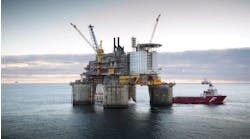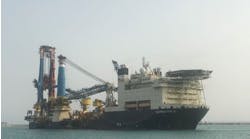Dry precommissioning offers subsea pipeline testing alternative
Pieter Swart, SeaLeopard Engineering
The field pressure test (hydrotest) was introduced in the US in the 1950s to avoid leakages or failures during startup of onshore gas pipelines. In those days, weld and manufacturing defects often went undetected, leading to gas leaks. The weld was often one of the weakest points, and hard to inspect consistently.
As such, the test became a success because it consistently revealed these types of defects prior to the introduction of hydrocarbons. The hydrotest was incorporated into the ASME B31.8 code and, due to its success, was later adopted in all international pipeline codes as a requirement before a pipeline system could be placed into operation. Over time, the hydrotest became a key pipeline construction and precommissioning milestone.
Hydrotesting disadvantages
There are, however, disadvantages of the hydrotest, especially for today’s subsea pipelines, with its requirement for costly installation vessels and operations in sensitive marine environments. Flooding and testing a pipeline with (inhibited) water can be cumbersome, and is fraught with challenges, to wit:
- The compressor spread, needed to dewater and dry the pipeline, is a costly component.
- A long period of critical time is required to dewater and dry long pipelines, particularly those used for dry gas.
- The inhibited water, discharged from the pipeline, could impact marine environments.
- Often the hydrotest is on the critical path and may affect the completion schedule.
- There are many opportunities for construction delays, since installation, tie-ins, and hydrotest have to be completed before the system hydrotest.
- The water can only remain in the pipeline for a limited time. If delays occur after completion of the test, dewatering may not be possible, which could then bring additional potential threats to pipeline integrity in the form of algae growth and corrosion.
Lately, the necessity of the hydrotest for long and large-diameter subsea pipelines has been questioned, as failures during testing have become rare offshore; and the fact that the hydrotest brings with it the possibility of HSE exposure, additional costs and project delays.
There are today a range of measures that make it possible to deliver an operational subsea pipeline that is free of unacceptable defects. These include advanced inspection of line pipe materials; sophisticated pipe manufacturing and handling techniques; automated welding; high-resolution, non-destructive testing; improved offshore installation methods; and advanced QA/QC systems. These advances have opened up new possibilities for long deepwater gas pipelines.
The DNV-96 ‘Rules for Submarine Pipeline Systems’ was the first pipeline code that suggested the possibility of an alternative to hydrotesting. Today, the DNV GL code states that “it is allowed to replace the hydrotest by alternative means, when the disadvantages with the hydrotest are extraordinary, and alternative means are available to ensure the same level of safety & integrity as with the hydrotest, and these are allowed by agreement.” The allowances are open for all pipelines.
Dry precommissioning
Dry precommissioning basically consists of a systematic alternative approach which proves the integrity of the pipeline by using HAZID and FMECA assessment techniques. This is performed throughout all phases of the project to identify all failure modes (i.e. the gross errors and defects) that would be revealed by the hydrotest. A DNV GL joint industry project called “REPLACE” is working to publish a guideline by the end of 2020. Meanwhile, a number of recent subsea pipeline projects, like TurkStream and Nord Stream 2, have used individual stringent criteria and independent certification as alternative to hydrotesting.
Table 1 gives an overview of all subsea pipelines that replaced the hydrotest with dry pre-commissioning techniques. These pipelines were constructed based on special requirements which mitigated failure modes. All of these pipelines are gas pipelines and all were certified by DNV GL.
Characteristics and prerequisites
The following characterizations can be observed for the pipeline projects that used dry pe-commissioning:
- The pipelines are generally long and/or large diameter gas export lines.
- Mostly thick-walled line pipe is used.
- All applied the DNV GL ST-F101 code for design, manufacturing and installation.
- All used third party verification and certification.
- All rely on strict QA/QC procedures and gauging, cleaning and caliper pigging inspection is applied afterwards.
- Alternative leak detection methods are possible prior to commissioning.
- None have reported leaks after commissioning. (of course, four cases do not constitute a reliable basis for statistical analysis).
- The pipelines were made of CMn steel.
Besides strict QA/QC procedures, there are other prerequisites used in the above projects, including:
- Minimum 17 mm wall thickness.
- Diameter to thickness ratio (D/t) < 45.
- SMLS or SAWL line pipe quality.
- All components hydrostatically pressure tested during manufacturing.
- Local leak testing after installation for tie-ins.
- No exposure to accumulated plastic strains.
- Automatic ultrasonic testing was performed after installation welding.
- Caliper pigging, cleaning and gauging apply.
There are a variety of reasons for performing employing dry pre-commissioning techniques instead of the field pressure test. However, there are also significant risks which, if not well understood, may have serious consequences. An overview is presented in Table 2. It presents an overview of the advantages for using dry pre-commissioning and also measures that could be used to avoid risk of pipeline failure during operation.
Conclusions
The following conclusions may be drawn:
- The field pressure test (or hydrotest) has been shown to be an effective way to prove pipeline integrity and hydrocarbon containment since the 1950s.
- Levels of quality in all aspects of a subsea pipeline (including pipe material, construction and testing, welding and installation) have improved significantly since the 1950s.
- Probability of having and therefore finding defects/gross errors has decreased significantly, but still common practice concludes that the hydrotest is required.
- DNVGL-ST-F101 opens the possibility for alternative measures to the hydrotest for subsea (gas) pipelines. It must be noted that the hydrotest is not waived, it is just replaced by alternative measures to detect gross errors and significant defects.
For subsea pipelines, dry precommissioning techniques have a lower HSE risk profile as compared to hydrostatic testing. If replacement mitigations are correctly used and verified, the method holds significant potential advantages.
It should be noted that since this is an alternative method, certification by an independent expert is a “must have,” to ensure that the test is replaced by adequate alternatives. For dry precommissioning of subsea pipelines, stringent and project-specific conditions must be defined well in advance, such that the same level of safety and integrity (as the hydrotest) can be achieved.
References
1. DNVGL-ST-F101:2017; Submarine pipeline systems
2. N. Hashem, K. Kamhawi and A. Walker; Gulf of Aqaba Pipeline Crossing, Presentation for OPT 2004.
3. J. Timmermans, A. Meijer and S. Ethembabaoglu; South Stream Deepwater Pipeline System – a Case for Waiving the Hydrotest, OMAE2014-24638.
4. O. Fyrileiv, Venas, Aamlid & Collberg: System pressure test for offshore pipelines – are there alternatives? OPT 2017.
5. S. Thornton, P. Dixon, Baker Hughes, J. Chaudhuri, South Stream Transport, “Innovations in Pipeline Pre-commissioning,” OPT 2020.





